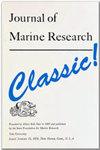利用细胞计数法和pH优化微藻絮凝眼珠藻
IF 0.5
4区 地球科学
Q3 Earth and Planetary Sciences
引用次数: 0
摘要
眼藻是一种含氮量高的微藻,如碳水化合物、蛋白质、脂质和氨基酸,被广泛用作生物柴油残留物,作为牲畜饲料的补充等。N.oculata的细胞非常小,直径为2-8µm,难以追踪。这使得眼猪笼草很难种植。微藻生长的一种方法是悬浮并优化pH。絮凝是对壳聚糖的絮凝。因此,本研究旨在研究壳聚糖浓度对N.oculata絮凝的效率。所使用的方法是实验室实验,所使用的计划是双因素析因设计(Kitosan和pH)。研究的进行程度从在玻璃顶上培养N.oculata六天开始,然后进行絮凝、数据收集和数据分析。这项研究使用了两个过程,即壳聚糖和pH优化。将行为分为三个浓度,分别为15、20和25 ppm,重复三次,而最终使用的pH为10。当进行浮选时,在0、20和40分钟内取样以测量浮选效率。研究表明,利用kitosan和pH优化对N.ocurata进行絮凝是一种有效且易于应用的方法,由此产生的絮凝效率已接近100%,这意味着絮凝是成功的。15ppm囊肿浓度样品絮凝的平均效率为85.27%,20ppm囊肿浓度为99.17%,25ppm囊肿浓度是99.99%。UNK。眼藻是一种营养丰富的微藻,涉及碳水化合物、蛋白质、脂质和氨基酸,因此被广泛用作生物柴油的原料,作为动物饲料的补充等。眼藻的细胞大小很小,从2-8µm不等,很难沉淀。这些因素使得N.oculata很难被收获。絮凝和pH优化是收获微藻的有效方法之一。所使用的絮凝剂材料是壳聚糖。因此,本研究旨在研究壳聚糖浓度对N.oculata絮凝的有效性。所使用的方法是实验室实验,采用双因素析因设计作为研究设计。研究的各个阶段开始于将N.oculata在玻璃罐中培养6天,然后进行絮凝、数据收集和数据分析。本研究采用了两种处理方法,即壳聚糖和pH优化。处理分为三个浓度,包括15、20、25 ppm和Ş,每个浓度重复3次,而使用的最终pH为10。在絮凝过程中,在0、20和40分钟取样以测量絮凝效率。结果表明,壳聚糖絮凝和pH优化是一种有效且易于应用的方法,絮凝效率接近100%,表明絮凝是成功的。15ppm壳聚糖、20ppm壳聚糖和25ppm壳聚糖的絮凝效率的平均值分别为85.27%、99.17%和99.99%。本文章由计算机程序翻译,如有差异,请以英文原文为准。
Flokulasi Mikroalga Nannochloropsis oculata Menggunakan Kitosan dan pengoptimalan pH
N. oculata merupakan salah satu jenis mikroalga yang memiliki kandungan nutisi yang tinggi seperti karbohidrat, protein, lipid, dan asam amino, sehingga banyak dimanfaatkan sebagai bahan baku biodiesel, sebagai suplemen pakan ternak, dll. N. oculata memiliki ukuran sel yang sangat kecil yakni berkisar 2-8 µm dan sulit mengendap. Faktor tersebut membuat N. oculata menjadi sulit untuk dipanen. Salah satu cara yang efisien untuk pemanenan mikroalga tersebut adalah metode flokulasi dan pengoptimalan pH. Bahan flokulan yang digunakan adalah kitosan. Dengan demikian, penelitian ini bertujuan untuk mempelajari efektivitas konsentrasi kitosan untuk flokulasi N. oculata. Metode yang digunakan adalah eksperimen laboratorium, dan rancangan yang digunakan adalah rancangan faktorial dua faktor (Kitosan dan pH). Tahapan pelaksanaan penelitian dimulai dari kultur N. oculata pada wadah toples kaca selama 6 hari, diikuti dengan flokulasi, dan pengumpulan data, dan analisis data. Penelitian menggunakan dua perlakuan, yakni kitosan dan optimalisasi pH. Perlakuan dikelompokkan menjadi tiga konsentrasi diantaranya adalah 15, 20, dan 25 ppm masing-masing 3 kali pengulangan, sedangkan pH akhir yang digunakan adalah 10. Ketika flokulasi berlangsung sampel diambil pada menit ke 0, 20, dan 40 untuk mengukur efisiensi flokulasinya. Hasil penelitian menunjukkan bahwa flokulasi N. oculata menggunakan kitosan dan optimalisasi pH merupakan metode yang efektif dan mudah diterapkan, dimana hasil efisiensi flokulasi yang diperoleh telah mendekati 100% yang berarti flokulasi berhasil dilakukan. Rata-rata nilai efisiensi flokulasi sampel konsentrasi kitosan 15 ppm adalah 85,27%, konsentrasi kitosan 20 ppm adalah 99,17%, dan konsentrasi kitosan 25 ppm adalah 99,99%. N. oculata is one type of microalgae that has high nutrients, involved carbohydrates, protein, lipids and amino acids, so it is widely used as raw material for biodiesel, as a supplement to animal feed, etc. N. oculata has a very small cell size ranging from 2-8 µm and is difficult to settle. These factors make it difficult for N. oculata to be harvested. One of the efficient ways to harvest microalgae is the method of flocculation and pH optimization. The flocculant material used is chitosan. Thus, this study aims to study the effectiveness of chitosan concentration for N. oculata flocculation. The method used was a laboratory experiment, with a two-factor factorial design as the research design. The stages of the research began with the culture of N. oculata in a glass jar for 6 days, followed by flocculation, data collection, and data analysis. This study used two treatments, namely chitosan and pH optimization. The treatments were grouped into three concentrations including 15, 20, 25 ppm and each with 3 repetitions, while the final pH used was 10. During the flocculation process, samples were taken at 0, 20, and 40 minutes to measure the flocculation efficiency. The results showed that N. oculata flocculation using chitosan and pH optimization were effective and easy to apply methods, where the flocculation efficiency results obtained were close to 100%, which means that the flocculation was successful. The average value of the flocculation efficiency of the 15 ppm chitosan was 85.27%, the 20 ppm chitosan was 99.17%, and the 25 ppm chitosan was 99.99%.
求助全文
通过发布文献求助,成功后即可免费获取论文全文。
去求助
来源期刊

Journal of Marine Research
地学-海洋学
自引率
0.00%
发文量
1
审稿时长
3 months
期刊介绍:
The Journal of Marine Research publishes peer-reviewed research articles covering a broad array of topics in physical, biological and chemical oceanography. Articles that deal with processes, as well as those that report significant observations, are welcome. In the area of biology, studies involving coupling between ecological and physical processes are preferred over those that report systematics. Authors benefit from thorough reviews of their manuscripts, where an attempt is made to maximize clarity. The time between submission and publication is kept to a minimum; there is no page charge.
 求助内容:
求助内容: 应助结果提醒方式:
应助结果提醒方式:


